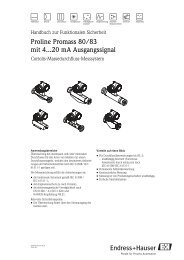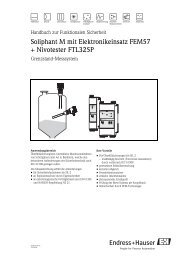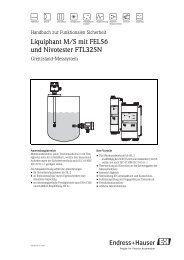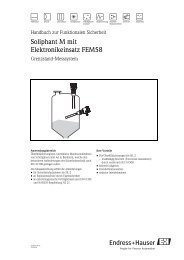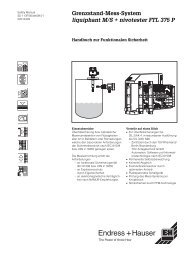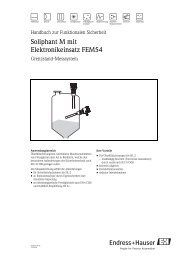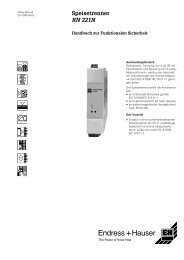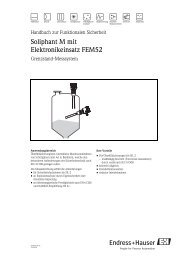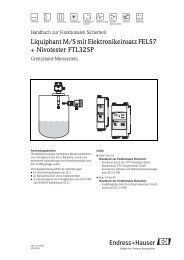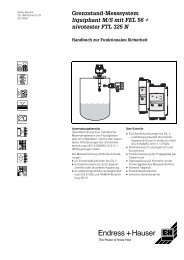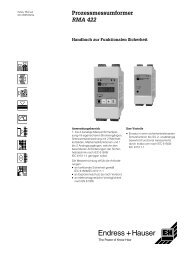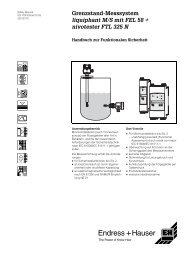Liquiphant S FDL 60, FDL 61 + Nivotester FTL 670 - Endress+Hauser
Liquiphant S FDL 60, FDL 61 + Nivotester FTL 670 - Endress+Hauser
Liquiphant S FDL 60, FDL 61 + Nivotester FTL 670 - Endress+Hauser
You also want an ePaper? Increase the reach of your titles
YUMPU automatically turns print PDFs into web optimized ePapers that Google loves.
Safet y Manual<br />
SD 175F/00/en/ 11. 03<br />
52021926<br />
Level limit measuring system<br />
liquiphant S <strong>FDL</strong> <strong>60</strong>, <strong>FDL</strong> <strong>61</strong> +<br />
nivotester <strong>FTL</strong> <strong>670</strong><br />
Functional safety manual<br />
Application<br />
Your benefits<br />
Overfill protection or operating maximum<br />
• For overfill protection up to SIL 3<br />
detection of all types of liquids in tanks to<br />
– Independently assessed<br />
satisfy particular safety systems<br />
(Functional Assessment) by<br />
requirements to IEC <strong>61</strong>508.<br />
TÜV SÜDDEUTSCHLAND to<br />
The measuring device fulfils the<br />
IEC <strong>61</strong>508<br />
requirements concerning<br />
• Suitable for pressure vessels with<br />
• Safety functions up to SIL 3<br />
liquefied gases according to VdTÜV,<br />
• Explosion protection through intrinsic Merkblatt 100<br />
safety<br />
– For tank categories B and C<br />
• EMC to EN <strong>61</strong>326 and NAMUR<br />
– No annual recurrent test required<br />
Recommendation NE 21.<br />
• Permanent self-monitoring<br />
• Fault message for line break and shortcircuit<br />
• Functional test of follow-up devices<br />
with press of button or remote<br />
operation<br />
• Monitoring for corrosion on the tuning<br />
fork of the sensor<br />
• No calibration<br />
• Insensitive to external vibration<br />
• Easy commissioning<br />
<strong>FTL</strong> <strong>670</strong><br />
s
Table of contents<br />
SIL declaration of conformity. . . . . . . . . . . . . . . . . . 3<br />
Validity of the Safety Manual . . . . . . . . . . . . . . . . . . 4<br />
Valid device versions . . . . . . . . . . . . . . . . . . . . . . . . . . . . . 4<br />
Introduction . . . . . . . . . . . . . . . . . . . . . . . . . . . . . . . . 5<br />
Abbreviations, standards and terms . . . . . . . . . . . . . . . . . . 5<br />
Determining the Safety Integrity Level (SIL) . . . . . . . . . . . . 5<br />
Safety function with <strong>Liquiphant</strong> S <strong>FDL</strong> <strong>60</strong>/<strong>61</strong><br />
and <strong>Nivotester</strong> <strong>FTL</strong> <strong>670</strong> . . . . . . . . . . . . . . . . . . . . . . 7<br />
Structure of the level limit measuring system . . . . . . . . . . . 7<br />
Permitted combinations for the safety function . . . . . . . . . . 8<br />
Supplementary device documentation . . . . . . . . . . . . . . . . 8<br />
Settings and installation instructions. . . . . . . . . . . 9<br />
Installation instructions . . . . . . . . . . . . . . . . . . . . . . . . . . . . 9<br />
Recurrent test for SIL 3 to IEC <strong>61</strong>508 . . . . . . . . . . . 9<br />
. . . . . . . . . . . . . . . . . . . . . . . . . . . . . . . . . . . . . . . . . . . . . . 9<br />
Response in operation and failure . . . . . . . . . . . . . 9<br />
. . . . . . . . . . . . . . . . . . . . . . . . . . . . . . . . . . . . . . . . . . . . . . 9<br />
Technical safety characteristic quantities . . . . . . 10<br />
Specific technical safety characteristic quantities<br />
and wiring options for the <strong>Liquiphant</strong> S <strong>FDL</strong> <strong>60</strong>/<strong>61</strong><br />
+ <strong>Nivotester</strong> <strong>FTL</strong> <strong>670</strong> measuring system . . . . . . . . . . . . . 10<br />
TÜV SÜDDEUTSCHLAND . . . . . . . . . . . . . . . . . . . . 11<br />
. . . . . . . . . . . . . . . . . . . . . . . . . . . . . . . . . . . . . . . . . . . . . 11<br />
<strong>Liquiphant</strong> S <strong>FDL</strong> <strong>60</strong>/<strong>61</strong> + <strong>Nivotester</strong> <strong>FTL</strong> <strong>670</strong> (FailSafe)<br />
2 Endress + Hauser
<strong>Liquiphant</strong> S <strong>FDL</strong> <strong>60</strong>/<strong>61</strong> + <strong>Nivotester</strong> <strong>FTL</strong> <strong>670</strong> (FailSafe)<br />
SIL declaration of conformity<br />
L0 0-<strong>FDL</strong>6 xxxx-01- 06- xx-a2- 000<br />
Endress + Hauser 3
<strong>Liquiphant</strong> S <strong>FDL</strong> <strong>60</strong>/<strong>61</strong> + <strong>Nivotester</strong> <strong>FTL</strong> <strong>670</strong> (FailSafe)<br />
Validity of the Safety Manual<br />
Valid device versions The evaluation described in this Safety Manual regarding functional safety is valid for the device<br />
versions and software versions specified below.<br />
Unless otherwise stated, all of the following versions can also be used for safety functions<br />
because they are subject to the internal modification process, within which the effects of<br />
modifications regarding functional safety are also evaluated.<br />
The valid device versions are:<br />
• <strong>Liquiphant</strong> S <strong>FDL</strong><strong>60</strong> - # ### # 7 #<br />
• <strong>Liquiphant</strong> S <strong>FDL</strong><strong>61</strong> - # ### # # 7 #<br />
in conjunction with <strong>Nivotester</strong> <strong>FTL</strong> <strong>670</strong>.<br />
4 Endress + Hauser
<strong>Liquiphant</strong> S <strong>FDL</strong> <strong>60</strong>/<strong>61</strong> + <strong>Nivotester</strong> <strong>FTL</strong> <strong>670</strong> (FailSafe)<br />
Introduction<br />
Abbreviations, standards Abbreviations<br />
and terms<br />
Information on abbreviations in connection with functional safety and their explanations can be<br />
found in the E+H brochure "Functional safety in the Process Industry - reducing risks with SIL"<br />
(SI 002Z) under www.endress.com/sil.<br />
Relevant standards<br />
Standard English<br />
IEC <strong>61</strong>508,<br />
Functional safety of electrical/elect ronic/ programmable elect ronic safety-related<br />
Part 1 - 7<br />
systems (Target group: Manufacturers and Suppliers of Devices)<br />
IEC <strong>61</strong>511,<br />
Functional safety - Safety Instrumented Systems for the process industry sector<br />
Part 1 - 3<br />
(Target group: Saf ety Instrumented Systems Designers, Integrat ors and Users)<br />
Terms<br />
Term E xplanation<br />
Dangerous failure Failure with the potential to put the safety-related system in a dangerous or<br />
non-f unctional condition.<br />
Safety-related system A safety-related system performs the safety functions that are required to<br />
achieve or maintain a safe condition e.g. in a plant. Example: sensor with<br />
switching amplifier (e.g. level switch), logic unit (e.g. PLC) and actuator<br />
(e.g. valve) form a safety-related system.<br />
Safety function Defined function, which is performed by a safety-related system with the aim of<br />
achieving or maintaining a safe condition for the plant, considering a specified<br />
dangerous incident . Example: limit level monitoring<br />
Determining the<br />
The achievable Safety Integrity Level is determined by the following technical safety<br />
Safety Integrity Level (SIL) characteristic quantities:<br />
• Average probability of Failure on Demand (PFDav )<br />
• Hardware Fault Tolerance (HFT) and<br />
• Safe Failure Fraction (SFF).<br />
The specific technical safety characteristic quantities for the <strong>Liquiphant</strong> S<br />
<strong>FDL</strong> <strong>60</strong>/<strong>61</strong> + <strong>Nivotester</strong> <strong>FTL</strong> <strong>670</strong> measuring system are listed in the "Technical safety<br />
characteristic quantities" chapter.<br />
The following table displays the dependence of the "Safety Integrity Level" (SIL) on the<br />
"Average probability of Failure on Demand" (PFDav). Here, the "Low demand mode" has been<br />
observed, i.e. the requirement rate for the safety-related system is on average once a year.<br />
Safety Integrity Level (SIL) PFDav (Low demand mode)<br />
4 ≥ 10-5 ...< 10-4 3 ≥≥ ≥ ≥10 -4 ...< 10 -<br />
33<br />
33<br />
2 ≥ 10 -3 ...< 10 -2<br />
1 ≥ 10 -2 ...< 10 -1<br />
Endress + Hauser 5
<strong>Liquiphant</strong> S <strong>FDL</strong> <strong>60</strong>/<strong>61</strong> + <strong>Nivotester</strong> <strong>FTL</strong> <strong>670</strong> (FailSafe)<br />
Sensor, logic unit and actuator together form a safety-related system, which performs a safety<br />
function. The "Average probability of Failure on Demand" (PFDav) is usually divided up into the<br />
sensor, logic unit and actuator sub-systems as per Figure 1.<br />
Sensor<br />
(e.g. Level Limit<br />
Measuring System)<br />
Logic Unit<br />
(e.g. PLC)<br />
Actuator<br />
(e.g. Valve)<br />
PFDav ≤ 35 % ≤ 15 % ≤ 50 % = 100 %<br />
L00 -<strong>FTL</strong> xxxxx-05- 06- xx-en- 000<br />
Fig. 1: usual division of the "Average probabilit y of Failure on Demand" (PFDav) into the sub-systems<br />
! Note!<br />
This documentation considers <strong>Liquiphant</strong> S <strong>FDL</strong> <strong>60</strong>/<strong>61</strong> + <strong>Nivotester</strong> <strong>FTL</strong> <strong>670</strong> as components of a<br />
safety function.<br />
-<br />
- -<br />
The following table displays the achievable "Safety Integrity Level" (SIL) of the entire safety-related<br />
system for type B systems depending on the "Safe Failure Fraction" (SFF) and the "Hardware Fault<br />
Tolerance" (HFT). Type B systems are, for example, sensors with complex components such as<br />
microprocessors (→see also IEC <strong>61</strong>508, Part 2).<br />
Safe Failure Fraction Hardware Fault Tolerance (HFT)<br />
(SFF)<br />
0 1 2<br />
< <strong>60</strong> % not permitted SIL 1 SIL 2<br />
<strong>60</strong> ...< 90% SIL 1 SIL 2 SIL 3<br />
90 ...< 99% SIL 2 SIL 3<br />
≥ 99 % SIL 3<br />
For <strong>Liquiphant</strong> S <strong>FDL</strong> <strong>60</strong>/<strong>61</strong> + <strong>Nivotester</strong> <strong>FTL</strong> <strong>670</strong>, the HFT-value 1 applies.<br />
The Safe Failure Fraction (SFF) is in the range of 90...< 99 %.<br />
6 Endress + Hauser
<strong>Liquiphant</strong> S <strong>FDL</strong> <strong>60</strong>/<strong>61</strong> + <strong>Nivotester</strong> <strong>FTL</strong> <strong>670</strong> (FailSafe)<br />
Safety function with <strong>Liquiphant</strong> S <strong>FDL</strong> <strong>60</strong>/<strong>61</strong><br />
and <strong>Nivotester</strong> <strong>FTL</strong> <strong>670</strong><br />
Structure of the level limit The measuring system's devices are displayed in the following diagram.<br />
measuring system<br />
Cover<br />
FEL 67 Electronic insert<br />
<strong>FTL</strong> <strong>670</strong><br />
<strong>Liquiphant</strong> S (FailSafe)<br />
s<br />
<strong>Liquiphant</strong> S <strong>FDL</strong> <strong>60</strong>/<strong>61</strong> with FEL 67 and Nivotest er <strong>FTL</strong> <strong>670</strong><br />
<strong>Nivotester</strong><br />
<strong>FTL</strong> <strong>670</strong><br />
L 00-F DL xxxxx-16- 06- xx-en- 000<br />
Safety function<br />
The measuring line only works in the overfill protection safety function (MAX safety) using the level<br />
relay.<br />
The level relay always works in quiescent current safety; i.e. the relay contact opens when:<br />
• The switch point is exceeded (level exceeds response height)<br />
• A fault occurs<br />
• The mains voltage fails<br />
In addition to the level relay, the fault-signalling contact (alarm relay) works in quiescent current<br />
safety and opens when:<br />
• One of the following faults occurs:<br />
– Fault in the sensor <strong>FDL</strong> <strong>60</strong>, <strong>FDL</strong> <strong>61</strong> (e.g. corrosion, electronics error)<br />
– Fault in data transfer<br />
– Fault in <strong>FTL</strong> <strong>670</strong> limit switch<br />
• The mains voltage fails<br />
! Note!<br />
When the alarm relay opens, the level relay also opens.<br />
Endress + Hauser 7
<strong>Liquiphant</strong> S <strong>FDL</strong> <strong>60</strong>/<strong>61</strong> + <strong>Nivotester</strong> <strong>FTL</strong> <strong>670</strong> (FailSafe)<br />
Permitted combinations The following combinations are permitted for the measuring system:<br />
for the safety function<br />
<strong>Nivotester</strong> <strong>Liquiphant</strong> S <strong>FDL</strong> <strong>60</strong>/<strong>61</strong> + FEL 67<br />
<strong>FTL</strong> <strong>670</strong><br />
<strong>FDL</strong> <strong>60</strong>-# ### # 7 #*<br />
Order number:<br />
<strong>FDL</strong> <strong>61</strong>-# ### # # 7 #*<br />
016501-0040<br />
Supplementary device<br />
documentation<br />
Permitted instrument types (# = all instrument versions permitted); * 7 = FEL 67<br />
Safety function data<br />
The safety function is guaranteed by the:<br />
• Redundant design of all the important electronic components in the <strong>Liquiphant</strong> S sensor with<br />
FEL 67<br />
• Redundant design of all the important electronic components in the <strong>Nivotester</strong> switching unit<br />
• Interference-free PFM- signal transmission<br />
The measuring system reacts as follows:<br />
– Approx. 0.5 s when the tuning fork is covered<br />
– Approx. 1.0 s when the tuning fork is exposed<br />
– When an error occurs: max. 3.0 s safety time<br />
! Note!<br />
MTTR (Mean Time To Repair) is set at 8 hours.<br />
Safety systems without a self-locking function must be monitored or set to an otherwise safe<br />
state after carrying out the safety function within MTTR.<br />
Depending on the version, the following documentation must be available for the measuring<br />
system:<br />
Devi ces Technical Information Explosion protection / Other documentation<br />
Operati ng Instructions, certifi cate<br />
(XA, ZE or ZD)<br />
Compact Instructions<br />
(TI + BA + KA)<br />
<strong>Liquiphant</strong> S TI 223F, BA 140F; Functional saf ety AK5 None<br />
<strong>FDL</strong> <strong>60</strong>/<strong>61</strong> + KA 031F<br />
TÜV (Product Service)<br />
Nivotest er <strong>FTL</strong> <strong>670</strong><br />
<strong>Liquiphant</strong> S TI 223F, BA 140F; Overfill protection for liquefied Safety Instructions<br />
<strong>FDL</strong> <strong>60</strong>, <strong>FDL</strong> <strong>61</strong><br />
gas<br />
ZE 126F<br />
<strong>Liquiphant</strong> S TI 223F, BA 140F; ATEX II 1/2 G<br />
Safety Instructions<br />
<strong>FDL</strong> <strong>60</strong>, <strong>FDL</strong> <strong>61</strong><br />
EEx ia IIC T6<br />
XA 027F<br />
Nivotest er <strong>FTL</strong> <strong>670</strong> TI 223F, BA 140F; ATEX II (1) G<br />
Safety Instructions<br />
KA 031F<br />
EEx [ia IIC]<br />
XA 069F<br />
" Caution!<br />
<strong>Liquiphant</strong> S TI 223F, BA 140F; Standard None<br />
<strong>FDL</strong> <strong>60</strong>/<strong>61</strong> + KA 031F<br />
Nivotest er <strong>FTL</strong> <strong>670</strong><br />
The installation and setting instructions, and the technical limit values must be observed in<br />
accordance with the Operating Instructions (BA 140F).<br />
For devices used in explosion-hazardous areas, the additional documentation (XA, ZE) in<br />
accordance with the table must also be observed.<br />
8 Endress + Hauser
<strong>Liquiphant</strong> S <strong>FDL</strong> <strong>60</strong>/<strong>61</strong> + <strong>Nivotester</strong> <strong>FTL</strong> <strong>670</strong> (FailSafe)<br />
Settings and installation instructions<br />
Installation instructions Since the application conditions have an effect on the safety of the measurement, please refer to<br />
the applicable device documentation for information regarding the correct installation of the<br />
<strong>Liquiphant</strong> S <strong>FDL</strong> <strong>60</strong>/<strong>61</strong> + <strong>Nivotester</strong> <strong>FTL</strong> <strong>670</strong>.<br />
The following settings are permitted for the safety function:<br />
Instrument Setting As-deli ver ed state<br />
<strong>Liquiphant</strong> S No settings possible. - - -<br />
<strong>FDL</strong> <strong>60</strong>/<strong>61</strong><br />
with FEL 67<br />
<strong>Nivotester</strong><br />
<strong>FTL</strong> <strong>670</strong><br />
Setting for product density:<br />
ρ > 0.50* (without jumper)<br />
ρ > 0.70 (with jumper)<br />
ρ > 0. 50* (without jumper)<br />
" Caution!<br />
*also suitable for liquefied gas ρ > 0. 44 .<br />
Observe the following for the <strong>Nivotester</strong> <strong>FTL</strong> <strong>670</strong>: The operator must use suitable measures<br />
(e.g. current limiter, fuse) to ensure the relay contact characteristics are not exceeded:<br />
• U ≤ 230 V AC 50/<strong>60</strong> Hz , I ≤ 2.5 A,<br />
P ≤ <strong>60</strong>0 VA at cos ϕ = 1.0 or P ≤ 300 VA at cos ϕ ≥ 0.7 or<br />
• U ≤ 120 V DC, I ≤ 2.5 A, P ≤ 75 W<br />
" Caution!<br />
Changes to the measuring system and settings after start-up can impair the protection function!<br />
Recurrent test for SIL 3 to IEC <strong>61</strong>508<br />
The operativeness of the measuring system must be checked every five years if the PFD av values<br />
given in the Appendix are used.<br />
This is required to avoid a small remaining risk which can never be ruled out for any safety-related<br />
function.<br />
Response in operation and failure<br />
! Note!<br />
The behaviour in operation and failure is described in the Operating Instructions BA 140F.<br />
Endress + Hauser 9
<strong>Liquiphant</strong> S <strong>FDL</strong> <strong>60</strong>/<strong>61</strong> + <strong>Nivotester</strong> <strong>FTL</strong> <strong>670</strong> (FailSafe)<br />
Technical safety characteristic quantities<br />
Specific technical safety The tables show the specific values and wiring options for the measuring system.<br />
characteristic quantities<br />
and wiring options for the Note!<br />
<strong>Liquiphant</strong> S <strong>FDL</strong> <strong>60</strong>/<strong>61</strong> + Note the following points on the tables below:<br />
<strong>Nivotester</strong> <strong>FTL</strong> <strong>670</strong><br />
• The wiring scheme shows the number of instruments (<strong>Liquiphant</strong> and <strong>Nivotester</strong>) and the limit<br />
measuring system<br />
relay contact circuits (open, when the sensor signals covering).<br />
1oo1 architecture (1 out of 1)<br />
<strong>Liquiphant</strong> S <strong>FDL</strong> <strong>60</strong>/<strong>61</strong><br />
Settings None<br />
<strong>Nivotester</strong> <strong>FTL</strong> <strong>670</strong><br />
Settings Density 0.44 / 0.7<br />
SIL SIL 3<br />
HFT 1<br />
SFF > 90 %<br />
PFD av ** 2.4 x 10-4 Recurrent test<br />
** TI (test interval) = every f ive years<br />
e.g. approaching level<br />
The PFD av of 2.4x10 -4 applies provided that the measuring line is tested every five years by<br />
approaching the liquid level.<br />
10 Endress + Hauser
<strong>Liquiphant</strong> S <strong>FDL</strong> <strong>60</strong>/<strong>61</strong> + <strong>Nivotester</strong> <strong>FTL</strong> <strong>670</strong> (FailSafe)<br />
TÜV SÜDDEUTSCHLAND<br />
L00- <strong>FDL</strong>6xxxx-0 1-06 -xx-xx- 002<br />
L00- <strong>FDL</strong>6xxxx-0 1-06 -xx-xx- 001<br />
Endress + Hauser 11
<strong>Liquiphant</strong> S <strong>FDL</strong> <strong>60</strong>/<strong>61</strong> + <strong>Nivotester</strong> <strong>FTL</strong> <strong>670</strong> (FailSafe)<br />
Deutschland Österreich Schweiz<br />
Vertrieb: Service: <strong>Endress+Hauser</strong><br />
<strong>Endress+Hauser</strong> <strong>Endress+Hauser</strong><br />
Beratung<br />
Help-Desk<br />
Messtechnik<br />
Messtechnik Ges.m.b.H. Metso AG<br />
Information<br />
Feldservice<br />
GmbH+Co. KG<br />
Lehnergasse 4<br />
Sternenhofstraße 21<br />
Auftrag<br />
Ersatzteile/Reparatur Colmarer Straße 6<br />
Bestellung<br />
Kalibrierung<br />
D-79576 Weil am Rhein<br />
A-1230 Wien<br />
CH-4153 Reinach/BL1<br />
Tel. (01) 8 80 56-0 Tel. (0 <strong>61</strong>) 7 15 75 75<br />
Fax (01) 8 80 56-335 Fax (0 <strong>61</strong>) 7 11 16 50<br />
E-Mail:<br />
E-Mail:<br />
Telefon: Telefon: Telefax:<br />
info@at.endress.com info@ch.endress.com<br />
0 800 EHVERTRIEB 0 800 EHSERVICE 0 800 EHFAXEN<br />
0 800 3 48 37 87<br />
0 800 3 47 37 84<br />
0 800 3 43 29 36<br />
E-Mail: E-Mail: Internet: Internet:<br />
info@de.endress.com service@de.endress.com www.at.endress.com www.ch.endress.com<br />
Internet: www.de.endress.com<br />
Technische Büros in: Hamburg . Hannover . Ratingen . Frankfurt . Stuttgart . München . Teltow<br />
08.02<br />
SD 175F/00/en/11.03<br />
52021926<br />
FM+SGML 6.0 ProMoDo<br />
52021926




